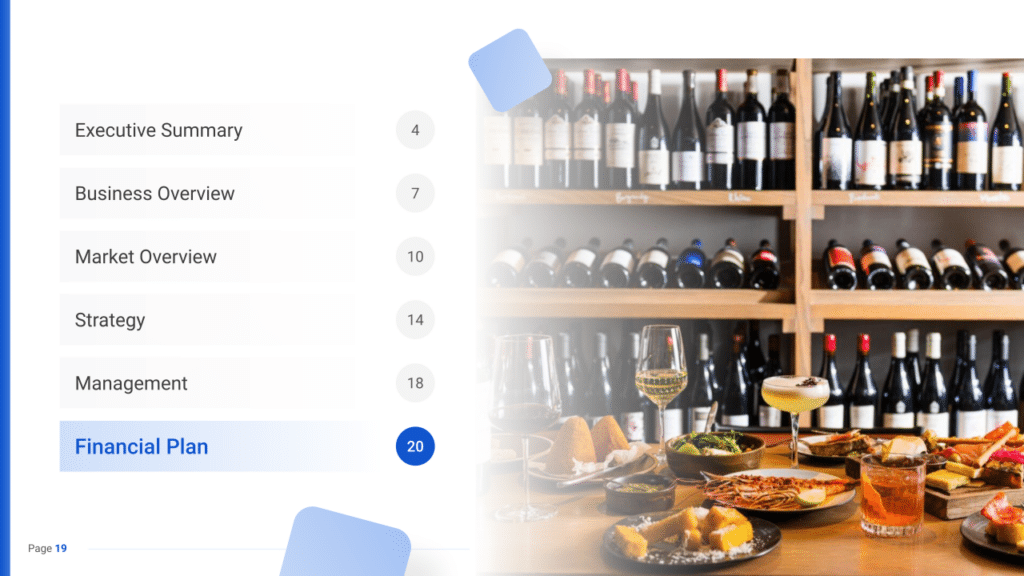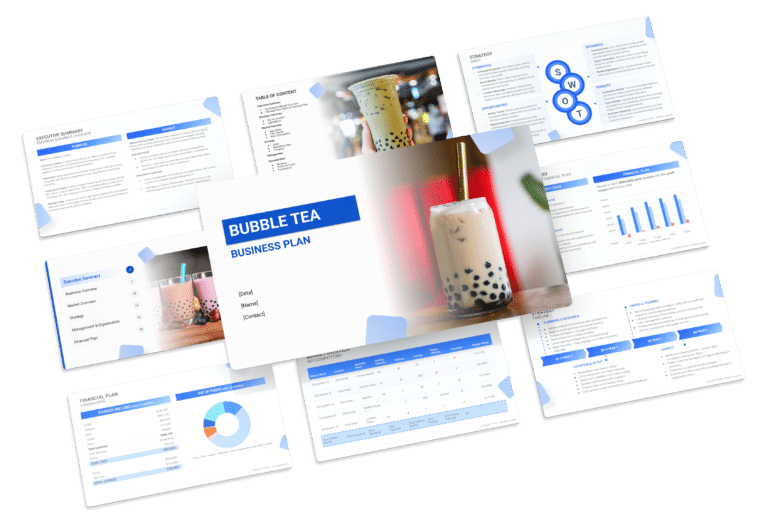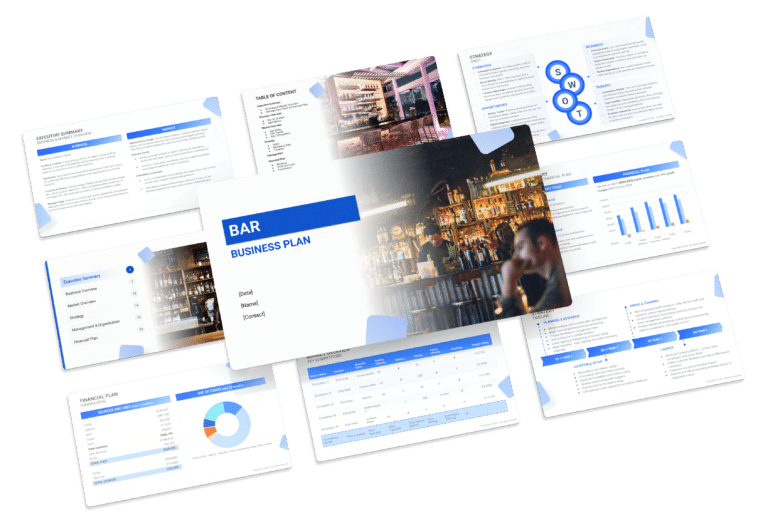Wine Bar Business Plan Template & PDF Example
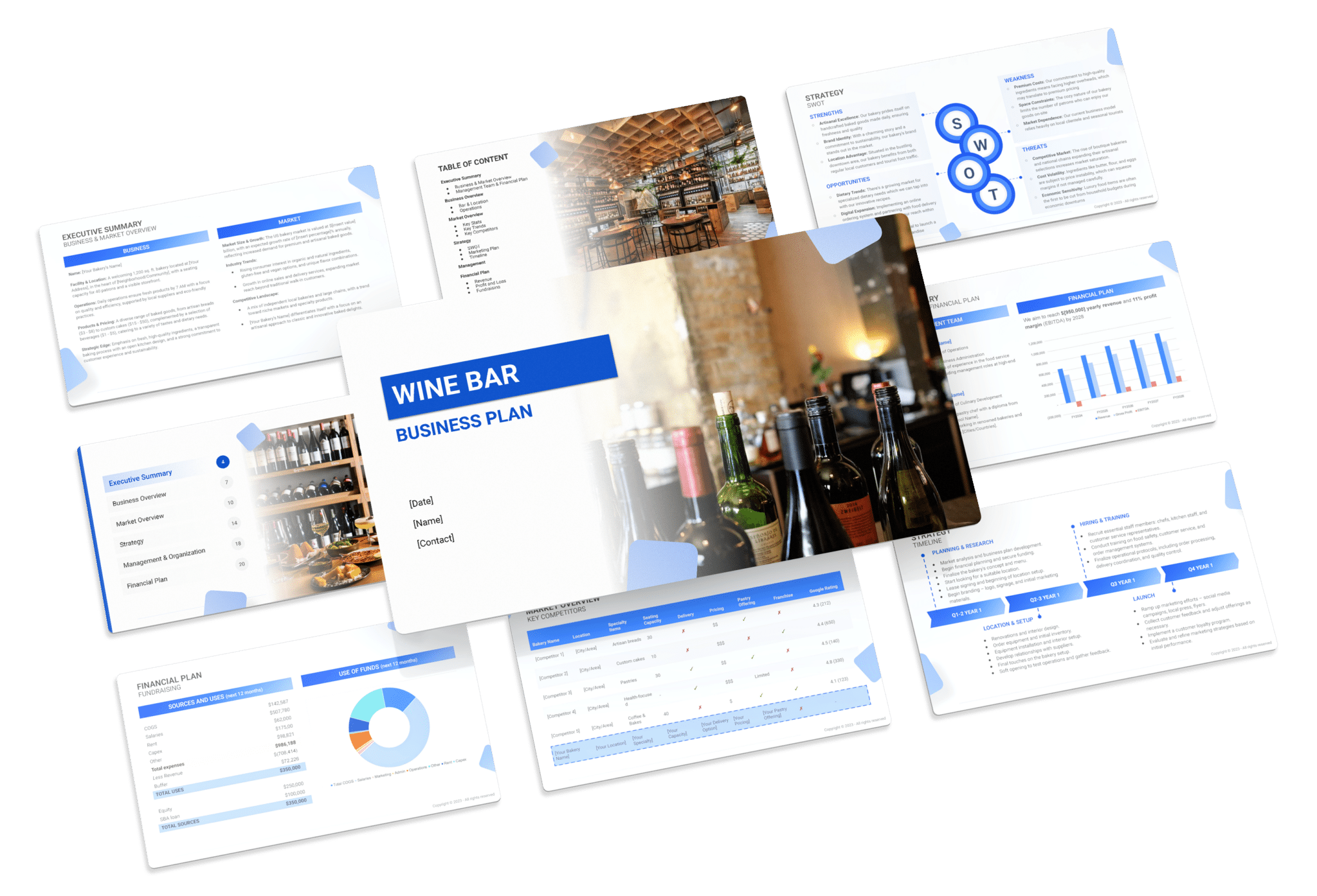
Creating a comprehensive business plan is crucial for launching and running a successful wine bar. This plan serves as your roadmap, detailing your vision, operational strategies, and financial plan. It helps establish your wine bar’s identity, navigate the competitive market, and secure funding for growth.
This article not only breaks down the critical components of a wine bar business plan, but also provides an example of a business plan to help you craft your own.
Whether you’re an experienced entrepreneur or new to the food and beverage industry, this guide, complete with a business plan example, lays the groundwork for turning your wine bar concept into reality. Let’s dive in!
The Plan
Our wine bar business plan is crafted to include all key components necessary for a thorough strategic framework. It outlines the bar’s operational guidelines, marketing approaches, industry landscape, competitive analysis, management team structure, and financial outlook.
- Executive Summary: Provides a concise overview of the Wine Bar’s proposition, emphasizing a sophisticated and relaxed atmosphere for wine enthusiasts, market analysis showcasing the sector’s growth and demand, the expertise of the management in wine selection and business operations, and a financial strategy that outlines investment opportunities and revenue forecasts.
- Business Overview: Offers detailed insights into the Wine Bar’s operational model:
- Wine Bar & Location: Describes the wine bar’s strategic location and elegant space, designed to offer guests a tranquil setting to enjoy a diverse range of wines sourced from local vineyards and international regions for example.
- Supply & Operations: Details the wine bar’s supply chain management, emphasizing partnerships with local wineries and global importers to curate an extensive wine list, and outlines efficient inventory management and operations to enhance the guest experience.
- Market Overview: Examines the wine bar industry landscape, identifying key players and establishing the wine bar’s unique niche:
- Key Stats: Presents data highlighting the market size, growth trends, and statistics that underscore the potential and necessity for sophisticated wine bars.
- Key Trends: Highlights significant trends such as the growing interest in organic wines, experiential dining with curated tastings, and food pairings.
- Key Competitors: Analyzes the main competitors in the vicinity, their offerings, and how the wine bar’s unique approach and services set it apart.
- Strategy: Outlines the wine bar’s strategic plan for growth and establishing a robust market presence:
- SWOT Analysis: Conducts a comprehensive analysis of Strengths, Weaknesses, Opportunities, and Threats to strategically position the wine bar.
- Marketing Plan: Details marketing strategies aimed at building brand visibility, attracting new guests, and retaining them through superior service, educational experiences, and targeted marketing efforts.
- Timeline: Sets forth key milestones and objectives from the wine bar’s setup to its launch and key growth phases.
- Management: Highlights the experienced team leading the wine bar, from certified sommeliers to business operations managers, emphasizing their roles in ensuring high-quality wine selection, guest satisfaction, and smooth operations.
- Financial Plan: Projects the financial outlook for the wine bar over the next few years, detailing revenue models from wine sales, events, and potentially retail products, cost management strategies, profit margins, and expected return on investment, ensuring a clear route to financial sustainability and growth.

Executive Summary
The Executive Summary introduces your wine bar’s business plan, providing a succinct overview of the establishment and its offerings. It should outline your market positioning, the variety of wines and related services you offer, its location, size, and a brief on daily operations.
This section should also delve into how your wine bar will integrate into the local community, including an analysis of direct competitors in the vicinity, identifying who they are, along with your wine bar’s distinctive selling points that set it apart from these competitors.
Moreover, you should include information about the management and founding team, detailing their roles and contributions to the wine bar’s success.
Additionally, a summary of your financial projections, including revenue and profits over the next five years, should be presented here to give a clear view of your wine bar’s financial strategy.
Wine Bar Business Plan Executive Summary Example
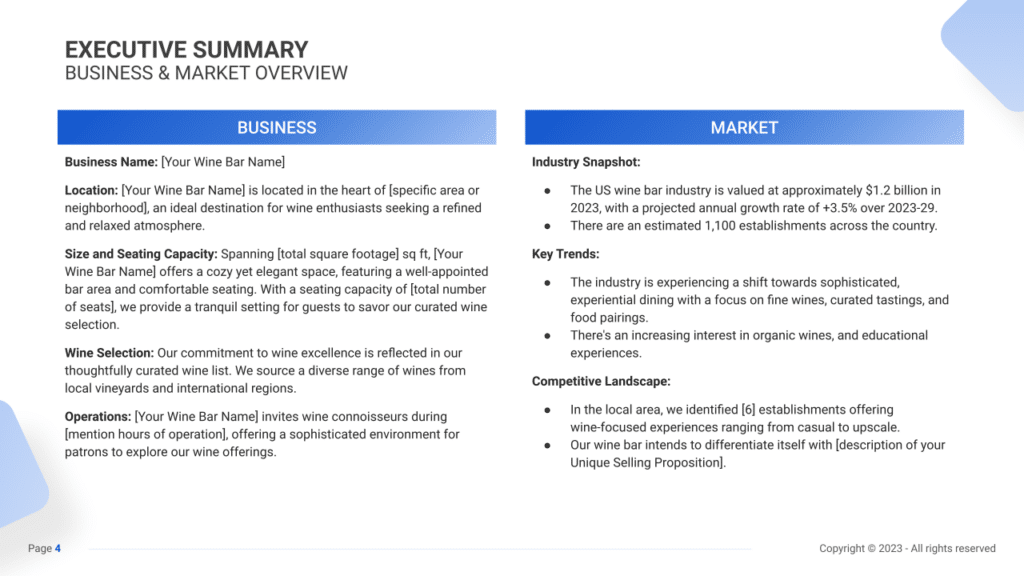
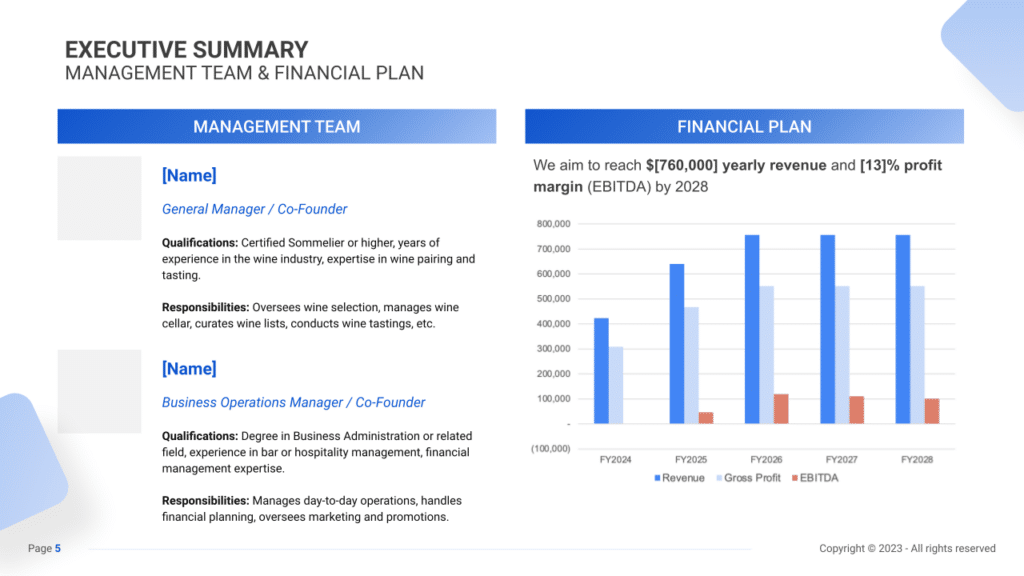
Business Overview
A concise overview is pivotal, introducing essential details like the bar’s name, location, ambiance, and a snapshot of its wine selection.
These details set the stage for your wine bar, framing its unique characteristics. A unique selling proposition (USP) distinguishes your bar. Whether it’s a focus on rare vintages, expertise in wine pairings, or a commitment to creating a refined yet relaxed wine experience, highlight this USP in your executive summary to showcase your bar’s distinctive value proposition.
Example:
“The Vintage Vineyard Wine Bar,” nestled in the heart of Vineyard Plaza, occupies a cozy yet sophisticated 1,500-square-foot space, offering a serene ambiance for wine enthusiasts. We curate an extensive wine selection sourced from local vineyards and global regions, presenting an exceptional tasting experience for patrons seeking wine excellence in a relaxed setting.
Market Overview
Understanding market dynamics and your position within them is crucial. This section should underscore the potential of the local wine and bar market, supported by relevant data such as market value and growth rates. Discussing trends, such as the increasing demand for unique wine experiences or the rise in wine appreciation culture, illuminates your bar’s positioning within the evolving landscape.
Additionally, it highlights the competitive landscape. Identify key competitors and elucidate how your wine bar stands out amidst the competition. Whether through specialized wine offerings, sommelier expertise, or a curated ambiance, emphasize how your bar differentiates itself.
Example:
In the local wine and bar market of Vineyard Plaza, valued at $1.5 million annually with a 10% growth rate, The Vintage Vineyard Wine Bar leads with a focus on premium wine experiences and a diverse wine selection. Amidst competition, our commitment to creating a refined yet inviting wine atmosphere positions us as the preferred choice for wine enthusiasts seeking quality selections.
Management Team
Highlight the expertise and background of your management team, showcasing their capabilities in driving bar success.
This could include your head sommelier’s extensive experience in wine curation or your operations lead’s proficiency in bar management. Demonstrating the team’s competency builds credibility and assures potential investors and partners of your bar’s potential for success.
Example:
At The Vintage Vineyard Wine Bar, Sarah Thompson, a Certified Sommelier with years of experience in wine pairing and tasting, leads our wine curation efforts. Supported by a bar manager, John Miller, with a degree in Business Administration and a strong background in hospitality management, the bar maintains a focus on delivering exceptional wine experiences and efficient operations.
Financial Plan
Provide an overview of your financial goals and projections, offering insights into revenue targets, profit margins, and anticipated growth trajectories.
Example:
The Vintage Vineyard Wine Bar aims for a projected revenue of $760,000 annually, targeting a 13% EBITDA profit margin by 2028. Investment in expanding our wine offerings, enhancing our bar’s ambiance, and strategic marketing initiatives geared towards wine enthusiasts drive anticipated growth and profitability within the local market.
Business Overview
For a Wine Bar, the Business Overview section can be succinctly divided into 2 main components:
Wine Bar & Location
Briefly describe the wine bar’s physical environment, focusing on its design, ambiance, and the inviting atmosphere that greets guests. Highlight the wine bar’s location, emphasizing its accessibility and the convenience it provides to patrons, such as proximity to cultural centers or ease of parking. Discuss why this location is strategic in attracting your target clientele.
Supply & Operations
Detail the range of wines and related offerings available, from local and international selections to pairings with small plates or artisanal snacks. Outline your sourcing strategy, emphasizing relationships with vineyards and distributors to ensure a diverse and high-quality wine selection. Present your pricing strategy, making sure it reflects the value of the experience provided and aligns with the market you’re targeting. Highlight any unique experiences, membership clubs, or loyalty programs that offer added value to your patrons, encouraging repeat visits and customer loyalty.
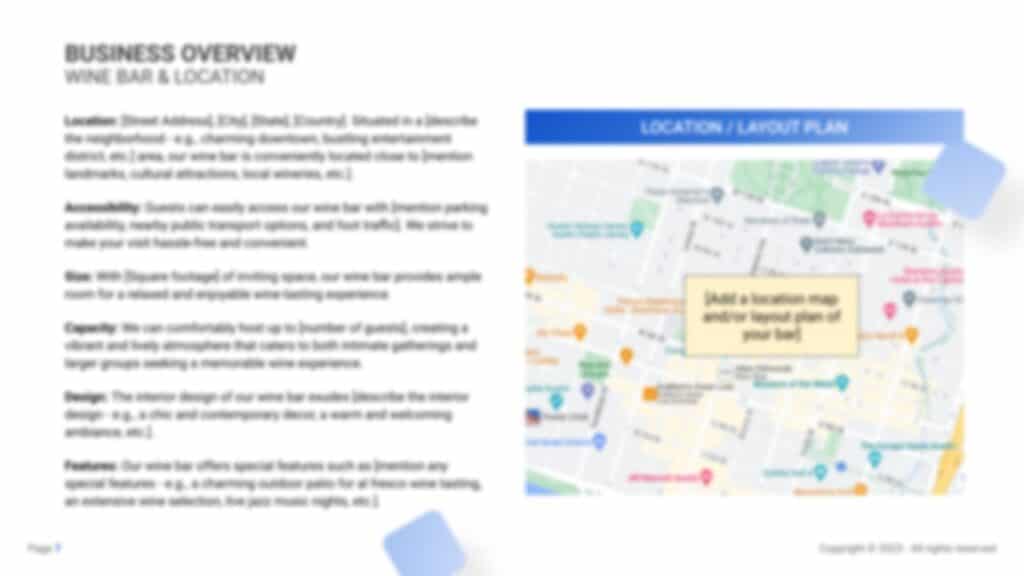
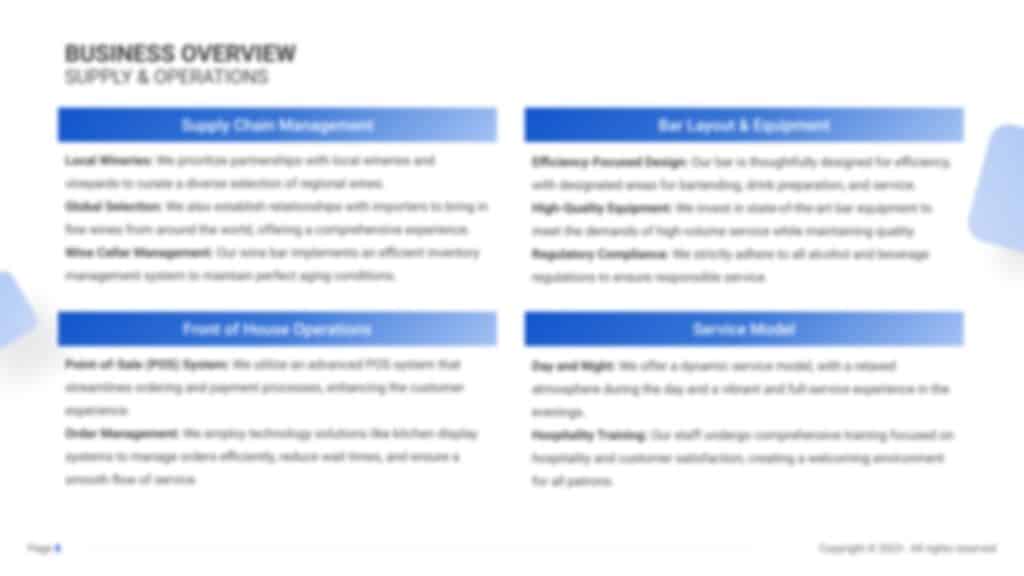
Market Overview
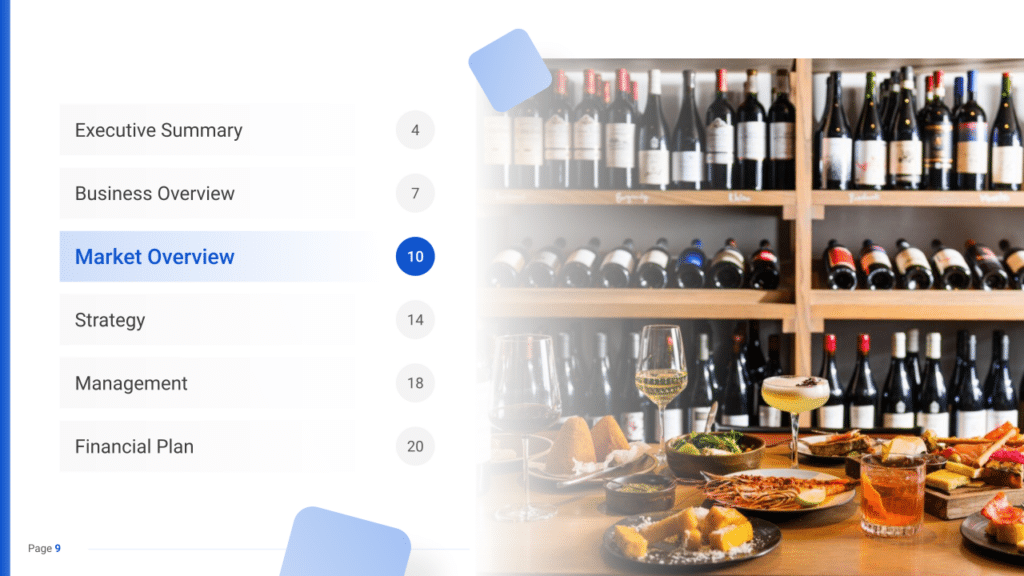
Industry size & growth
In the Market Overview of your wine bar business plan, start by examining the size of the wine industry and its growth potential. This analysis is essential for understanding the market’s breadth and identifying opportunities for expansion.
Key market trends
Proceed to discuss recent market trends, such as the increasing consumer interest in artisanal and boutique wines, organic and biodynamic vineyards, and unique wine-tasting experiences.
For example, highlight the demand for wine bars that offer curated selections from small producers, educational wine-tasting events, and pairings with gourmet snacks or meals.
Competitive Landscape
A competitive analysis is not just a tool for gauging the position of your wine bar in the market and its key competitors; it’s also a fundamental component of your business plan.
This analysis helps in identifying your wine bar’s unique selling points, which are essential for differentiating your business in a competitive market.
In addition, competitive analysis is integral in laying a solid foundation for your business plan. By examining various operational aspects of your competitors, you gain valuable information that ensures your business plan is robust, informed, and tailored to succeed in the current market environment.
Identifying Your Wine Bar Competitors
Initiate your competitive analysis by identifying local wine bars and establishments offering wine-related services. Direct competitors might include wine bars known for their extensive wine lists or specialized bars focusing on specific regions or varieties of wine. Indirect competitors may comprise upscale restaurants offering diverse wine selections or specialty liquor stores providing wine-tasting events.
Utilize online tools like Google Maps and review platforms such as Yelp or Untappd to map out competitor locations and gauge customer sentiment. For instance, if “Vineyard Elegance” is consistently praised for its sommelier-led tasting events, this stands as a notable strength of your competitor.

Wine Bar Competitors’ Strategies
Analyzing the strategies of your competitors involves several key facets:
- Wine Selection: Assess the breadth and depth of their wine offerings. If “Vintage Vines” is gaining traction for its collection of rare and aged wines, this signals a potential market trend toward curated, specialized selections.
- Ambiance and Services: Consider the ambiance and additional services offered. A wine bar like “Urban Cellar” might attract a younger demographic with its trendy decor and live music events, while “Estate Elixirs” may cater to a more sophisticated clientele with private tasting rooms and wine-pairing dinners.
- Pricing and Value: Compare pricing structures. Are your wine prices similar to those at “Affordable Elegance Wine Bar,” or do they align more with the premium range at “Grand Cru Estates”?
- Marketing Strategies: Evaluate their marketing approaches. Do competitors leverage social media extensively, or do they rely on collaborations with local vineyards and sommeliers to promote their brand?
- Customer Experience: Examine the overall customer experience. For instance, “Vintage Flavors Wine Bar” might be renowned for its knowledgeable staff and educational wine-tasting sessions, enhancing the customer’s journey.
- Operational Innovations: Look for technological advancements or unique processes implemented by competitors, such as “Tech-Savvy Cellars,” employing mobile apps for wine recommendations and ordering.
What’s Your Wine Bar’s Unique Proposition?
Reflect on your wine bar’s unique value proposition. Perhaps your establishment is celebrated for its exclusive collection of organic or biodynamic wines, or maybe it’s the ambiance of an intimate, speakeasy-style setting that sets you apart.
Identify market gaps through customer feedback and industry trends. For instance, if there’s a burgeoning interest in natural wines or sustainable viticulture practices, addressing this demand could be a distinguishing factor for your wine bar.
Consider your location: A wine bar situated in a tourist-heavy district might focus on wine tourism and curated tasting experiences, whereas one in a suburban setting might emphasize community engagement and wine education events for residents.
Strategy
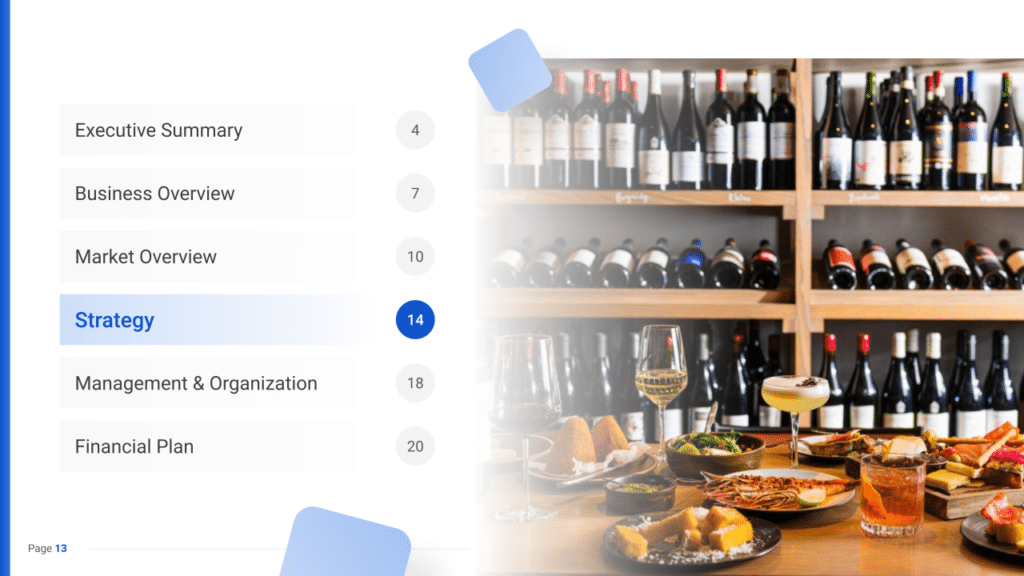
SWOT
First, conduct a SWOT analysis for the wine bar, highlighting Strengths (such as an exclusive wine selection and knowledgeable staff), Weaknesses (including potential high operational costs or strong competition in the area), Opportunities (for example, a growing interest in wine culture and pairing experiences), and Threats (such as economic downturns that may reduce consumer spending on dining and entertainment).

Marketing Plan
Next, develop a marketing strategy that outlines how to attract and retain customers through targeted advertising, promotional events like wine tastings, an engaging social media presence that showcases your wine selections and events, and involvement in community activities to enhance local visibility.
Marketing Channels
Utilize various marketing channels to reach potential patrons and create awareness about your wine bar’s offerings and ambiance.
Digital Marketing
Utilize online platforms to expand your reach:
- Social Media: Engage customers on platforms like Instagram by sharing enticing visuals of your wines, Facebook for event announcements, and Twitter for quick updates and promotions.
- Email Marketing: Build an email list to send newsletters featuring wine recommendations, upcoming events, and exclusive offers to subscribers.
- Website and SEO: Develop a user-friendly website showcasing your wine selections, events calendar, and blog with wine-related content. Optimize it for local SEO to attract online traffic.
Local Advertising
Connect with the local community:
- Flyers and Print Ads: Distribute visually appealing flyers at local events, restaurants, and wine shops. Advertise in local publications and newspapers.
- Events and Collaborations: Host or sponsor local events, such as wine tastings, live music nights, or charity fundraisers. Collaborate with local businesses for joint promotions and events.
Promotional Activities
Entice potential patrons with appealing offers:
- Happy Hours and Special Deals: Introduce happy hours, wine flights, or themed tasting nights to attract customers during off-peak hours. Offer seasonal promotions or discounts for group reservations.
- Loyalty Programs: Implement a loyalty program where frequent patrons earn rewards or discounts based on their visits or purchases.
- Referral Incentives: Encourage existing customers to refer friends by offering discounts or complimentary tastings for successful referrals.

Sales Channels
Maximize revenue and enhance the customer experience through effective sales channels and strategies.
In-Bar Sales Strategies
Enhance sales within your wine bar:
- Upselling Techniques: Train staff to suggest wine pairings, upsell premium wines, or offer tasting flights to increase the average check per customer.
- Wine Club or Membership: Create a membership program offering exclusive access to limited wines, discounts, or VIP events for regular patrons.
- Merchandise Sales: Sell branded merchandise like wine glasses, corkscrews, or gift baskets to promote brand loyalty and serve as souvenirs for patrons.
Online Sales and Reservation System
Optimize technology for increased sales:
- Online Reservation System: Implement an easy-to-use online reservation system through your website or third-party platforms to streamline bookings.
- E-Commerce: Sell select wines online for pickup or delivery, along with curated wine bundles or gift sets.
- Virtual Tastings and Events: Host virtual tastings or wine-related workshops online for remote customers, offering wine packages for purchase in advance.
Membership and Loyalty Programs
Encourage customer retention and frequent visits:
- Membership Benefits: Design membership programs with perks like discounts on wine purchases, exclusive events, or early access to new wine releases.
- Loyalty Rewards: Develop a digital loyalty program rewarding points for purchases, redeemable for discounts or special privileges.
Strategy Timeline
Finally, create a detailed timeline that outlines critical milestones for the wine bar’s opening, marketing initiatives, customer base growth, and expansion goals, ensuring the business advances with clear direction and intent.

Management
The management section focuses on the wine bar’s management and their direct roles in daily operations and strategic direction. This part is crucial for understanding who is responsible for making key decisions and driving the wine bar toward its financial and operational goals.
For your wine bar business plan, list the core team members, their specific responsibilities, and how their expertise supports the business.
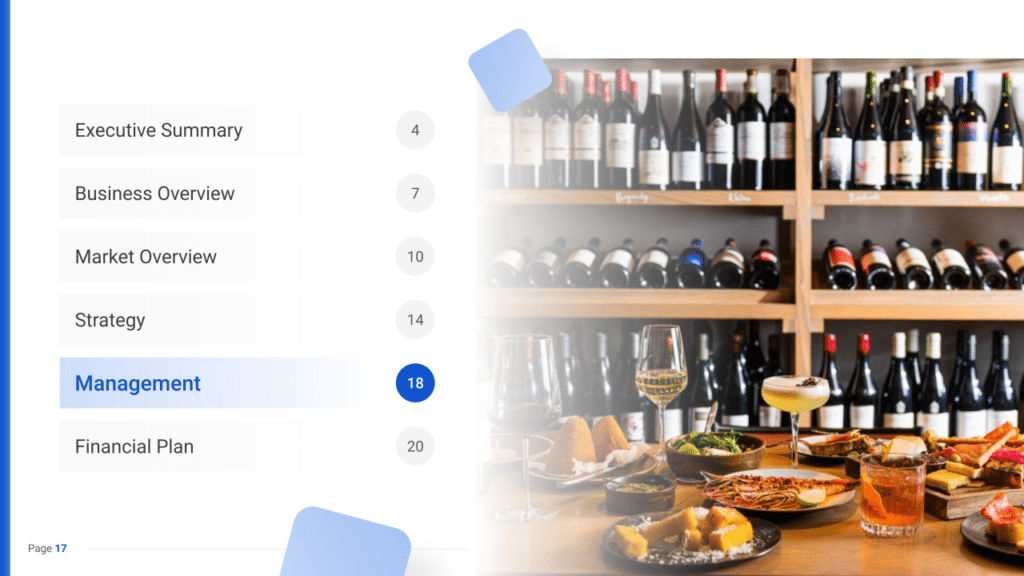

Financial Plan
The Financial Plan section is a comprehensive analysis of your financial projections for revenue, expenses, and profitability. It lays out your wine bar’s approach to securing funding, managing cash flow, and achieving breakeven.
This section typically includes detailed forecasts for the first 5 years of operation, highlighting expected revenue, operating costs and capital expenditures.
For your wine bar business plan, provide a snapshot of your financial statement (profit and loss, balance sheet, cash flow statement), as well as your key assumptions (e.g. number of customers and prices, expenses, etc.).
Make sure to cover here
_ Profit and Loss
_ Cash Flow Statement
_ Balance Sheet
_ Use of Funds
